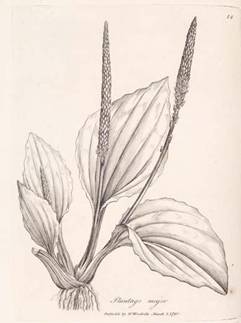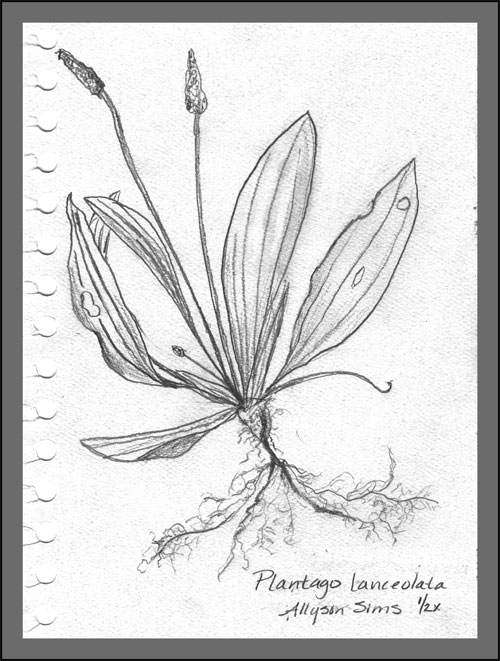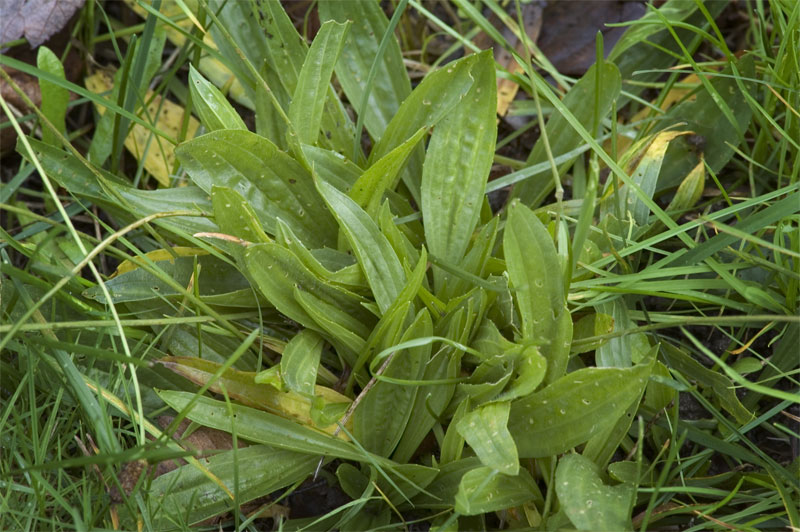English Plantain
Family name: Plantain
Family name: Plantaginaceae
Latin name: Plantago major, Plantago lanceolata
Common Names: English plantain, Common plantain, Ribwort, Birdseed plantain, Rippleseed plantain, Waybread, Buckhorn.
Related Species: There are about 200 species of plantain. The most interesting one I have come across is Plantago maritime ssp. Juncoides.Common Names: Seaside plantain, Goose-tongue

Body System Affiliation
- Dermatological
- Digestive System
- Respiratory
Botanical Description:
Habit: Herb, perennial weed
Size: 7” – 12” in flower
Arrangement: Alternate leaves
Leaves: Basal rosette of oval or lance shaped leaves with smooth margins, each leaf has 3-5 prominent ribs.
Flowers: Clusters appear on leafless stalk, numerous greenish-white flowers are short stalked.
Fruit: Capsules, oblong, egg-shaped; splits around the middle to release seeds, each capsule contains 5-30 seeds.
Underground Parts: Short fibrous roots.
Ecology:
Habitat: Roadsides, fields, pastures, lawns, any disturbed ground; grows in any soil, in sun to part shade.
Range: Grows almost everywhere up and down the Pacific coast, over into the Rockies. Some sources say it is countrywide (8:228, 10:23).
Native Where: Eurasia
Ecological Relationships: It is so aggressive that it is considered a weed. As a weed, Common plantain is an alternate host for tobacco mosaic, aster yellows, beet curly top, beet yellow, tobacco streak, and tomato spot wilt virus (3:339). It can also choke out other more desirable plants or lawn.
Places/Dates Observed/Description: My yard, in the grass and in the garden flower beds, whenever I am out in the garden, weeding or cultivating. I have also seen it frequently in the gardens at the Longhouse all this fall quarter, have pulled them out, tossed them out, taken some home and photographed them – nice healthy specimens growing in that area. I was made aware of what this plant was when I took an ethno-botany course at Olympic Peninsula Institute near Port Angeles in 2001. At the Institute, we identified the longer leafed Plantago lanceolata, the wider leafed Plantago major, as well as Plantago maritime. This latter species was the best tasting and fun to seek out.
Propagation:
Technique: Readily self sows with the wind, or stepped upon the seeds are carried to another place and quickly germinate. There are people who collect the seed. It is taken in the fall, then stratified before planting to increase germination rate about 70 percent (7:203).
Timing: Autumn
Harvest:
Plant Part: Leaves, roots and seeds
Season of Harvest: Spring through fall
Method of Harvest: Picking leaves as needed, fresh or dried or digging up entire plant.
Ecological Considerations of Harvest: Keeping a weedy plant at bay.
Cultural Considerations of Harvest: Inexpensive alternative for first aid, such as treating cuts, scrapes, bee stings, poison ivy…
Indigenous and Non-Western Use/Significance/Relationships:
Food: Cherokee have eaten plantain as a vegetable (P. maritime) using cut leaves and stems cooked with fatback
Dena’ina and other groups of Alaska have eaten the succulent, salty leaves mixed with fresh or marine mammal grease. Today they are jarred for winter use (1:328).
Indians gathered young shoots and broke them up, mashed with water,
then took the flourlike, made little patties, baked them in the sun to eat (10:23, 2:199).
The internet lists dozens of specific Native American uses at reference (9).
Medicine:
-
Parts Used: Leaves
Medicinal Actions: Anti-inflammatory, antiseptic, analgesic
Indications: Rashes, minor cuts, splinters, scrapes, bee stings, poison ivy, headaches, contusions, burns,
Body Systems Associations: Dermatological, Digestive
Energetics: Cooling
Harvest: Pick leaves
Storage: Use fresh or dried
Preparation: For poultice, chew leaves with saliva, spit out or heat leaves.
Applications: Poultice on affected areas, cold or warm, wrap with more whole leaves.
Pharmacy: 2-3xday until irritation subsides, usually 2-3 days.
Medicine:
Parts Used: Leaves
Medicinal Actions: Anti-inflammatory, diuretic, alterative. Rich in vitamins A, C and K.
Indications: Sore throat, coughs, bronchitis, mouth sores, diarrhea, dysentery, intestinal worms and bleeding of mucous membranes (2:199).
Body System Associations: Digestive, respiratory, circulatory. Harvest: Pick fresh leaves.
Storage: Fresh or dried
Preparation: Make into a tea
Applications: Drink as a tea.
Strong tea has also been used to control dandruff. Medicine:
Parts Used: Seeds
Medical Actions: Laxative
Also used as a hair wave set gel. Food – ground into flour, mixed with water and baked.
Medicine:
Parts Used: Roots
Medicinal Actions: Analgesic, anti-inflammatory
Indications: Toothache, sore gums, headache
Harvest: Dig up plant, clean roots off
Preparation & Applications: Chew as needed
Western (European-American) Uses/Relationships:
Food: Young leaves are good fresh, in salads or steamed as you would spinach (5:416). Seeds can be dried and ground into meal or flour for use in bread or pancakes (2:199).
Parts Used: Leaves, roots, seeds
Medicinal Actions: Anti-inflammatory, antiseptic, analgesic, digestive aid, anti-microbial, alterative, astringent, styptic, vulnerary (10:23).
Indications: bee stings, minor cuts and scrapes, poison ivy, headaches (1:329). Sore throat, laryngitis, coughs, bronchitis, tuberculosis, mouth sores (2:199).
Body System Affiliations: Dermatological, Digestive, Repertory.
Constituents: Provides beta carotene and calcium. Contains mucilage – a carbohydrate fiber. Contains monoterpene alkaloids, glycosides, sugars, triterpenes, fixed oil, linoleic acid and tannins (8:228). Contains flavinoids, allantoin (2:199).
Preparation: Chew or chop leaves, infusion of leaves, tea, lotion, grind seeds, chew roots, tea of roots.
Applications: Apply as a poultice, drink as a tea, apply lotion topically, chew leaves or roots.
Pharmacy: Juice internally, tincture 1-2 teaspoons up to 3 times a day, preserved with 30% alcohol, 35% glycerin, or simmered for 20 minutes with an equal volume of honey. Fresh leaves as a poultice.
Cautions: Taken internally, Plantain can act as a mild laxative.
Personal Experience:
I thought I had numerous specimens in my yard. When I went out to harvest I could only find one lonely plant nearly decayed away for the winter. This called for a trip to the garden at the Longhouse at Evergreen. The very plants I recently photographed now needed to come home with me. It was after 5:00 when I got to campus and I knew it would be dark. I thought the light from the building would shed enough light for me to find my catch. With a plastic bag and trowel in hand I briskly walked over to the garden. It was a soft, dim light. Having been in the garden many times now, I knew where some was. But the big juicy guys I really wanted were in the lawn by the leaf pile. I called to them and asked them to help me find them. I walked around talking to them, reviewing the wet spot I found one, a lumpy place I found another and I was successful in finding quite a bit. The ground was nearly frozen (it’s supposed to snow tonight) and my hands were very muddy and cold, but oh so glad to have two species of Plantain!
Wow! Preparation of this plant took much, much longer than I had anticipated - about 4 hours. I took all my plants, knocked the mud off them, then soaked and rinsed and soaked them again. It was more tedoius than cleaning spinach. I then separated the P. major from the P. lanceolata. I snipped the best leaves from the roots, removed seed stems first. Then I sorted out the best of the roots and leaves, set them out on paper towels to dry.
I did some leaf rubbings for a bit of art, if I rubbed too hard the paper got wet and fell apart. I didn't really get the effect I wanted, but I did get some faint rubbings.
Next, I tasted the leaves. P. major is not quite as bitter or stringy as P. lanceolata. Both taste a bit like chard and leave a film on the teeth the way spinach does, and the aftertaste was okay. Both are quite tough, I think this is due to the time of year I harvested. They would probably be more tender in the summer. I will try this experiment again next spring and summer.
I chopped the leaves, all the while keeping the two species separate for maximum knowledge on the two separately. I added a little water to make a paste to put on a wire cut on my thumb. It did not stick at all and fell apart easily. I chewed some up, adding plenty of saliva. I applied the mash as poultice to a canker sore inside my lip and also to my thumb. It stuck great! I was able to leave the poultice on my thumb till it dried - about 20 minutes. I could only take having a green glob on my lip about 5 minutes.
My thumb is the same this morning, probably need to apply it more often to see results. My canker sore is less painful though.
Next I made an infusion P. lanceolata for tea. I let it steep for about 20 minutes. It smelled good. Sort of like fresh grass or nettles.
While the tea steeped, I tried chewing the roots of P. major, since they were more plump than the P. lanceolata. The taste was milder than the leaves.
I had a cup of tea, the aroma is quite nice; earthy, grassy, green, warm like summer. It tasted mild and therapeutic. I added a touch of honey to some and did not like it as well.
I had my son, Taylor (15) try some. He was the one who thought it tasted like nettle tea. Not quite like the green tea he usually drinks. He also described it at smelling like summer grass. He noted that the smell was not as dominant when it was really hot, the subtleties came out when it cooled at bit. He launched into a long series of questions on whether I was going to become an herbal hippie- as he thought I was close any way. He pictured me living in a cottage made of herbs, down to my bedding stuffed with aromatic herbs and herbs of every kind hanging from the ceiling.
The seeds are difficult to harvest when they are wet. They are definitely ripe, but they need to be dry to harvest. I cannot see myself going to the trouble of that time consuming task. The few I got out were tasteless.
I will continue to drink tea from the leaves I gathered. They are all cleaned and chopped and drying nicely. I think it will be a nice tea to drink before bed as the smell and taste are very soothing. I think it would also be good for mild tummy aches.
References Cited:
- Mackinnon, Andy, and Jim Pojar. Plants of the Pacific NorthwestCoast. Vancouver, British Columbia: Ministry of Forests and Lone Pine Publishing, 1994.
- Kershaw, Linda J. Edible and Medicinal Plants of the Rockies. Edmonton, Alberta, Canada: Lone Pine Publishing, 2000.
- Moore, Michael. Medicinal Plants of the Pacific Northwest. Santa Fe, NM: Red Crane Books, 1993.
- Royer, France and Richard Dickinson. Weeds of the Northern U.S. and Canada. Edmonton, Alberta, Canada; The University of Alberta Press and Renton, WA: Lone Pine Publishing, 1999.
- Rodale’s Illustrated Encyclopedia of Herbs. Rodale Press Inc., 1987,
- Tierra, L.Ac., AHG, Leslie. A Kid’s Herb Book. Brandon, OR: Robert D. Reed Publishers, 2000.
- Hartung, Tammi Ruth. Growing 101 Herbs that Heal. North Adams, MA: Storey Publishing, 2000.
- Brill, Steve with Evelyn Dean. Identifying and Harvesting Edible and Medicinal Plants. New York, NY: HarperCollins Publisher’s Inc., 1994.
- 2. Moerman, Daniel E. Native American Ethnobotany Database. Aug 1999. Online at http://www.umdumich.edu/cgi-bin/herb/. Visited 3-9-2001.
- Haas, M.D., Elson M. Staying Healthy with the Seasons. Berkeley, CA: Celestial Arts, 1981, 2003.
Allyson Sims - Arts, Environment and the Child; Walking the Wheel
Fall Quarter 2005

Plantago lanceolata drawn from a plant I picked and pressed from my back yard a few weeks ago.
November 2005

Plantago lanceolata
Photograhed at LHG at TESC by Allyson Sims
Plantago major

KID FRIENDLY VERSION
